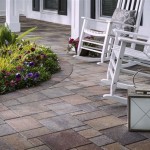Leveling Patio Pavers: The Perfect Finishing Touch
A patio provides an outdoor extension of a home, offering space for relaxation, entertainment, and dining. The aesthetic appeal and functionality of a patio are significantly influenced by the quality of its installation. A critical aspect of patio installation is ensuring that the pavers are level. Leveling patio pavers is not merely an aesthetic consideration; it is crucial for safety, durability, and water drainage. Uneven pavers can present tripping hazards, lead to structural issues, and cause water to pool on the surface, potentially damaging the paver material and the underlying base. This article will discuss the importance of leveling patio pavers and provide a comprehensive guide to the process.
The successful installation of level patio pavers requires meticulous planning, the right tools, and a clear understanding of the necessary steps. Before starting the installation, assessing the existing landscape is essential. This assessment involves determining the existing grade, identifying any potential drainage problems, and planning the layout of the patio. The choice of paver material also influences the leveling process. Different paver materials, such as concrete, brick, or natural stone, may require different leveling techniques and tools.
Importance of Proper Leveling
The importance of properly leveled patio pavers extends beyond aesthetics. Uneven pavers pose various risks and can compromise the long-term integrity of the patio. Here are some key reasons why leveling is crucial:
Safety: Uneven pavers create tripping hazards, increasing the risk of falls and injuries, especially for children and the elderly. A consistently level surface minimizes these risks and ensures a safe environment for everyone using the patio.
Durability: When pavers are not level, they are subjected to uneven stress distribution. This can lead to cracking, chipping, and premature wear and tear. Leveling distributes weight evenly across the entire patio surface, extending its lifespan and reducing the need for frequent repairs.
Water Drainage: Proper leveling allows for effective water runoff, directing rainwater away from the patio and preventing pooling. Standing water can damage pavers and the underlying base, leading to structural problems and the growth of mold and mildew. A properly graded and leveled patio ensures efficient drainage, protecting the patio and surrounding landscape.
Aesthetics: A level patio surface creates a visually appealing and professional look. Uneven pavers detract from the overall aesthetic and can make the patio appear unfinished and poorly maintained. Leveling ensures a smooth, uniform surface that enhances the beauty of the outdoor space.
Furniture Stability: Level pavers provide a stable surface for outdoor furniture, preventing tables and chairs from wobbling or tipping over. This ensures a comfortable and enjoyable experience for those using the patio for dining or relaxation.
Tools and Materials Required
Before embarking on the leveling process, gathering the necessary tools and materials is essential. Having the right equipment on hand will streamline the process and ensure accurate and efficient leveling. Here is a list of essential tools and materials:
Pavers: The choice of paver material depends on personal preference, budget, and the overall design of the patio. Common paver materials include concrete, brick, natural stone, and permeable pavers.
Base Material: A compacted base of gravel or crushed stone is essential for providing a stable foundation for the pavers. The type and thickness of the base material depend on soil conditions and the expected load on the patio. Typically, a base of 4-6 inches of compacted gravel is recommended.
Leveling Sand: A layer of leveling sand is spread over the compacted base to create a smooth and even surface for the pavers. The leveling sand should be fine and free of debris. Concrete sand or paver sand are suitable options.
Measuring Tools: A measuring tape and a level are essential for accurately measuring and leveling the patio surface. A laser level can also be used for larger patios to ensure precise leveling over greater distances.
Shovels and Rakes: Shovels are used for moving and spreading base material and leveling sand. Rakes are used to smooth and level the surface of the base and the sand layer.
Compacting Equipment: A plate compactor is used to compact the base material, ensuring a solid and stable foundation for the pavers. A hand tamper can be used for smaller patios or for areas that are difficult to reach with a plate compactor.
Rubber Mallet: A rubber mallet is used to tap pavers into place and to adjust their height during the leveling process. The rubber mallet prevents damage to the paver surface.
String Line: String lines are used to establish a level reference point and to ensure that the pavers are installed in a straight line. String lines are particularly useful for larger patios or for patios with complex layouts.
Safety Gear: Safety glasses, gloves, and knee pads are essential for protecting yourself during the leveling process. Safety glasses protect your eyes from dust and debris, gloves protect your hands from abrasion, and knee pads provide cushioning and support for your knees.
Step-by-Step Guide to Leveling Patio Pavers
The following steps provide a comprehensive guide to leveling patio pavers, ensuring a professional and durable result:
Step 1: Site Preparation Clearing the area of any vegetation, debris, and existing structures is the first step. This involves removing grass, weeds, rocks, and any other obstacles that may interfere with the installation process. The area should be excavated to the required depth, taking into account the thickness of the base material, leveling sand, and pavers. Typically, the excavation depth should be 8-10 inches below the desired finished grade.
Step 2: Base Installation Spreading and compacting the base material is crucial for providing a stable foundation. The base material should be spread evenly over the excavated area and then compacted using a plate compactor. The base material should be compacted in layers, typically 2-3 inches thick, to ensure proper compaction. Checking the level of the base is essential as it is being compacted. Ensuring the base is level will simplify the leveling of the pavers. A slight slope (1-2%) should be incorporated to facilitate water drainage.
Step 3: Leveling Sand Layer Spreading a layer of leveling sand over the compacted base provides a smooth and even surface for the pavers. The leveling sand should be spread to a depth of about 1 inch. Screed boards are used to create a consistent thickness of sand. Draw the screed boards across the base, removing excess sand and filling in any low spots. Check the level of the leveling sand layer using a level and make any necessary adjustments.
Step 4: Paver Placement Carefully placing the pavers on the leveled sand layer, maintaining consistent spacing between the pavers is the next step. Use paver spacers to ensure uniform joints. Gently tap each paver into place using a rubber mallet. Avoid hitting the pavers too hard, as this can damage them.
Step 5: Leveling and Adjustments Using a level to check the level of each paver individually as they are being placed is essential. If a paver is too high, remove it and remove some of the leveling sand underneath. If a paver is too low, add more leveling sand. Use the rubber mallet to gently tap the paver into place after making adjustments. Check the level frequently to ensure that the pavers are consistently level.
Step 6: Joint Sanding After placing and leveling all the pavers, sweeping joint sand into the joints between the pavers stabilizes them and prevents shifting. Use a broom to sweep the sand into the joints, ensuring that they are completely filled. Compact the sand into the joints using a plate compactor with a rubber mat attachment. This will help to settle the sand and prevent it from washing away. After compacting, sweep away any excess sand from the paver surface. Wetting the sand with a fine mist of water can help it to settle and harden.
Step 7: Final Inspection and Adjustments Conducting a final inspection of the patio surface, checking for any uneven pavers or gaps in the joints is the last step. Make any necessary adjustments to ensure that the patio is level and that the joints are filled with sand. Clean the paver surface to remove any remaining sand or debris.
By following these steps carefully, anyone can successfully level patio pavers and create a beautiful and durable outdoor space. Remember to take your time, pay attention to detail, and use the right tools and materials for the job. A well-leveled patio will provide years of enjoyment and enhance the value of your home.

Your Ultimate Guide To Seamless Paver Installation

Which Pavers Are Best For Patios Mortar City Masonry

Get Inspired Paver Patio Design Mutual Materials

40 Paver Patio Ideas To Help You Design Your Outdoor Space

Concrete Pavers Slabs For Patios Driveways More Belgard

Outdoor Patio Pavers Complete List Of Materials

Transforming Your Outdoor Space How To Design The Perfect Paver Patio Setti

How To Choose The Best Patio Paving For Your Garden Se Landscape Construction Award Winning Design Essex Landscaping

10 Patios That Use Paver Patterns To Make A Statement Unilock

40 Paver Patio Ideas To Help You Design Your Outdoor Space
Related Posts








